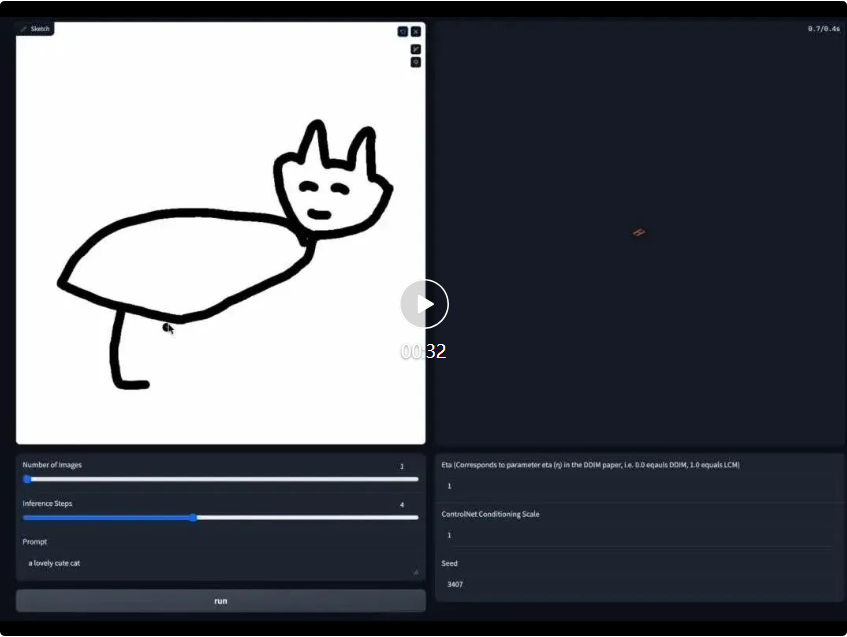 Technology peripherals
Technology peripherals
 AI
AI
 Accelerate diffusion model, generate SOTA-level images in the fastest 1 step, Byte Hyper-SD is open source
Accelerate diffusion model, generate SOTA-level images in the fastest 1 step, Byte Hyper-SD is open source
Accelerate diffusion model, generate SOTA-level images in the fastest 1 step, Byte Hyper-SD is open source
Apr 25, 2024 pm 05:25 PMRecently, Diffusion Model has made significant progress in the field of image generation, bringing unprecedented development opportunities to image generation and video generation tasks. Despite the impressive results, the multi-step iterative denoising properties inherent in the inference process of diffusion models result in high computational costs. Recently, a series of diffusion model distillation algorithms have emerged to accelerate the inference process of diffusion models. These methods can be roughly divided into two categories: i) trajectory-preserving distillation; ii) trajectory reconstruction distillation. However, these two types of methods are limited by the limited effect ceiling or changes in the output domain.
In order to solve these problems, the ByteDance technical team proposed a trajectory segmentation consistency model called Hyper-SD. Hyper-SD's open source has also been recognized by Huggingface CEO Clem Delangue.
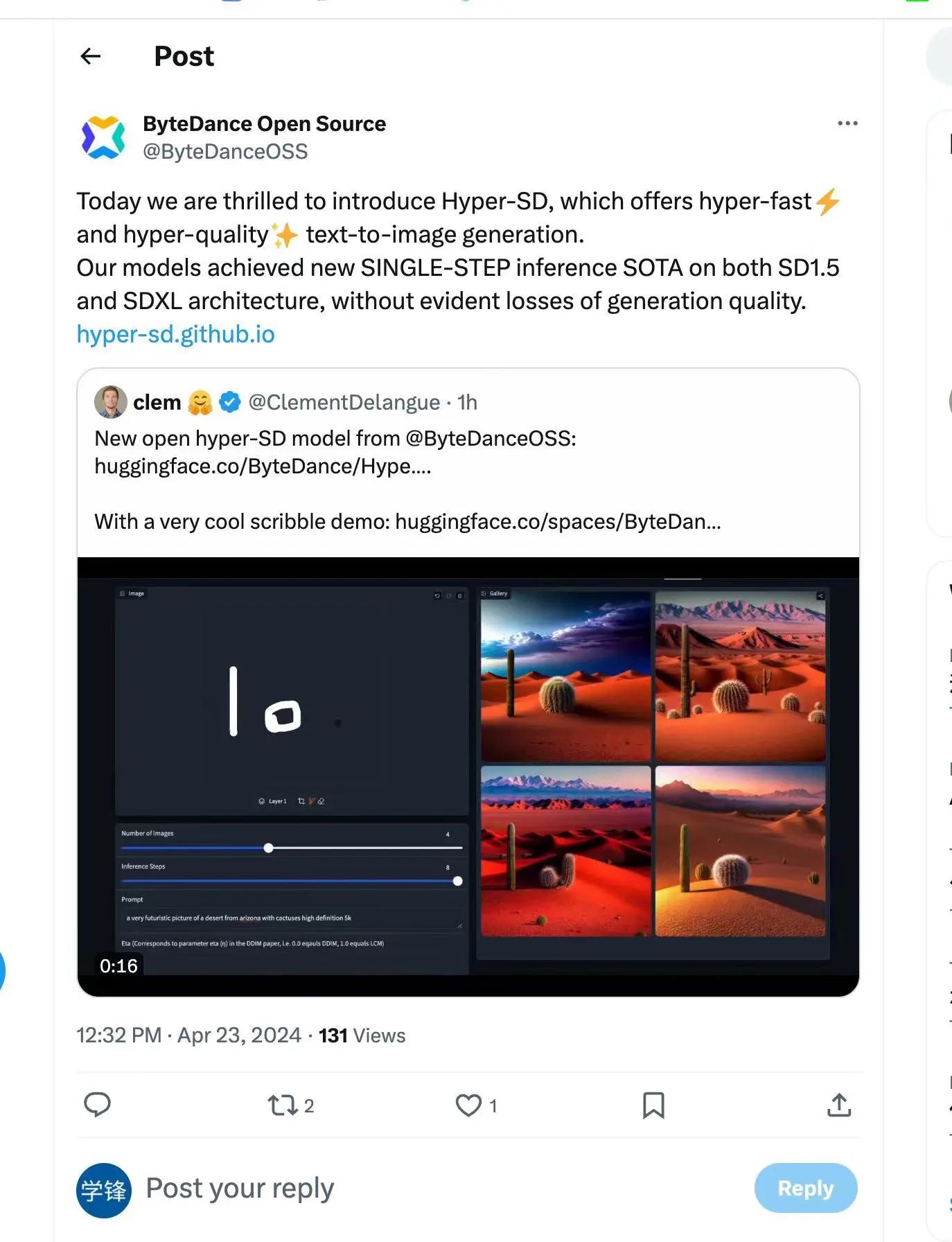
This model is a novel diffusion model distillation framework that combines the advantages of trajectory-preserving distillation and trajectory reconstruction distillation, while compressing the number of denoising steps. while maintaining near-lossless performance. Compared with existing diffusion model acceleration algorithms, this method achieves excellent acceleration results. Verified by extensive experiments and user reviews, Hyper-SD can achieve SOTA-level image generation performance in 1 to 8 steps of generation on both SDXL and SD1.5 architectures.
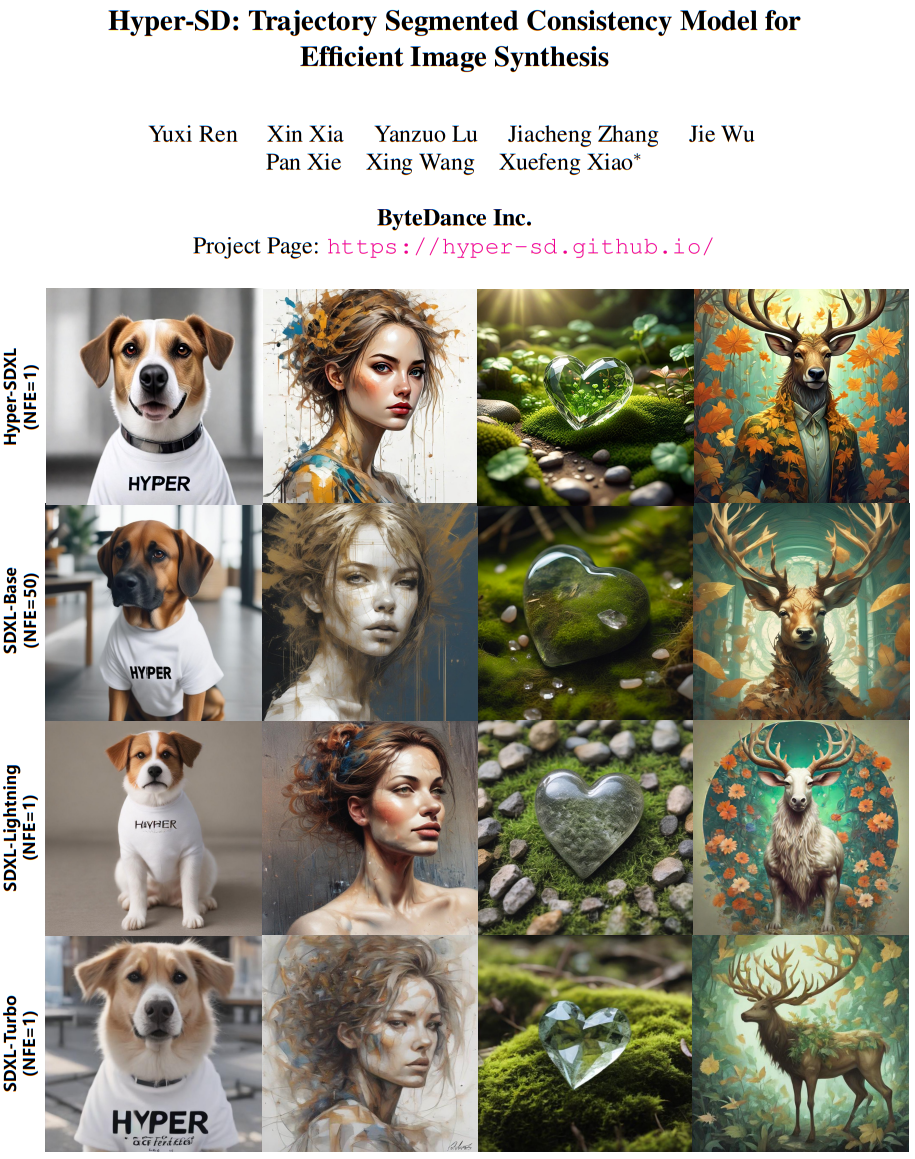
Project homepage: https://hyper-sd.github.io/
Paper link : https://arxiv.org/abs/2404.13686
Huggingface Link: https://huggingface.co/ByteDance/Hyper-SD
Single-step generated Demo link: https://huggingface.co/spaces/ByteDance/Hyper-SDXL-1Step-T2I
Real-time drawing board Demo link: https://huggingface. co/spaces/ByteDance/Hyper-SD15-Scribble

Method
1. Trajectory segmentation consistency distillation
Consistency Distillation (CD) [24] and Consistency Trajectory Model (CTM) [4] both aim to transform the diffusion model into a consistency model for the entire time step range [0, T] through one-shot distillation. However, these distillation models often fail to achieve optimality due to limitations in model fitting capabilities. Inspired by the soft consistency objective introduced in CTM, we refine the training process by dividing the entire time step range [0, T] into k segments and performing piecewise consistent model distillation step by step.
In the first stage, we set k=8 and use the original diffusion model to initialize  and
and  . The starting time step
. The starting time step  is uniformly randomly sampled from
is uniformly randomly sampled from  . We then sample the end time step
. We then sample the end time step  , where
, where  is calculated as follows:
is calculated as follows:
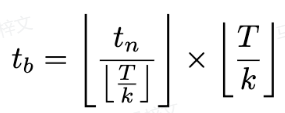
The training loss is calculated as follows:


Where  is calculated by formula 3,
is calculated by formula 3,  represents the exponential moving average (EMA) of the student model.
represents the exponential moving average (EMA) of the student model.
Subsequently, we restore the model weights from the previous stage and continue training , gradually reducing k to [4,2,1]. It is worth noting that k=1 corresponds to the standard CTM training scheme. For the distance metric d, we employ a mixture of adversarial loss and mean squared error (MSE) loss. In experiments, we observed that the MSE loss is more effective when the predicted and target values ??are close (e.g., for k=8, 4), while the adversarial loss increases as the difference between the predicted and target values ??increases. becomes more precise (for example, for k=2, 1). Therefore, we dynamically increase the weight of the adversarial loss and decrease the weight of the MSE loss throughout the training phase. In addition, we also integrate a noise perturbation mechanism to enhance training stability. Take the two-stage Trajectory Segment Consensus Distillation (TSCD) process as an example. As shown in the figure below, we perform independent consistency distillation in the
, gradually reducing k to [4,2,1]. It is worth noting that k=1 corresponds to the standard CTM training scheme. For the distance metric d, we employ a mixture of adversarial loss and mean squared error (MSE) loss. In experiments, we observed that the MSE loss is more effective when the predicted and target values ??are close (e.g., for k=8, 4), while the adversarial loss increases as the difference between the predicted and target values ??increases. becomes more precise (for example, for k=2, 1). Therefore, we dynamically increase the weight of the adversarial loss and decrease the weight of the MSE loss throughout the training phase. In addition, we also integrate a noise perturbation mechanism to enhance training stability. Take the two-stage Trajectory Segment Consensus Distillation (TSCD) process as an example. As shown in the figure below, we perform independent consistency distillation in the  and
and  time periods in the first stage, and then perform global consistency trajectory distillation based on the consistency distillation results of the previous two periods.
time periods in the first stage, and then perform global consistency trajectory distillation based on the consistency distillation results of the previous two periods.

The complete algorithm process is as follows:
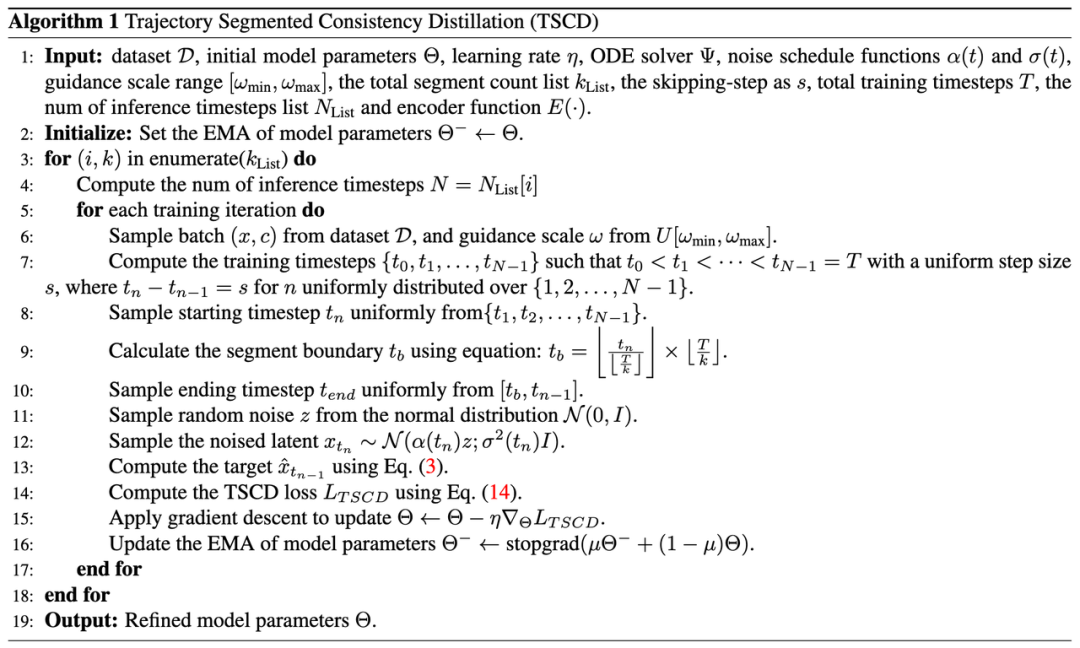
2. Human feedback learning
In addition to distillation, we further incorporate feedback learning to improve the performance of the accelerated diffusion model. Specifically, we improve the generation quality of accelerated models by leveraging human aesthetic preferences and feedback from existing visual perception models. For aesthetic feedback, we utilize the LAION aesthetic predictor and the aesthetic preference reward model provided in ImageReward to guide the model to generate more aesthetic images, as follows:

Where  is the aesthetic reward model, including the aesthetic predictor of the LAION dataset and ImageReward model, c is the text prompt,
is the aesthetic reward model, including the aesthetic predictor of the LAION dataset and ImageReward model, c is the text prompt,  is used together with the ReLU function as the hinge loss. In addition to feedback from aesthetic preferences, we note that existing visual perception models embedding rich prior knowledge about images can also serve as good feedback providers. Empirically, we find that instance segmentation models can guide the model to generate well-structured objects. Specifically, we first diffuse the noise on image
is used together with the ReLU function as the hinge loss. In addition to feedback from aesthetic preferences, we note that existing visual perception models embedding rich prior knowledge about images can also serve as good feedback providers. Empirically, we find that instance segmentation models can guide the model to generate well-structured objects. Specifically, we first diffuse the noise on image  in the latent space to
in the latent space to  , after which, similar to ImageReward, we perform iterative denoising until a specific time step
, after which, similar to ImageReward, we perform iterative denoising until a specific time step  and predict
and predict  directly. We then leverage a perceptual instance segmentation model to evaluate the performance of structure generation by examining the difference between instance segmentation annotations for real images and instance segmentation predictions for denoised images, as follows:
directly. We then leverage a perceptual instance segmentation model to evaluate the performance of structure generation by examining the difference between instance segmentation annotations for real images and instance segmentation predictions for denoised images, as follows:

Where  is the instance segmentation model (such as SOLO). Instance segmentation models can more accurately capture the structural defects of generated images and provide more targeted feedback signals. It is worth noting that in addition to instance segmentation models, other perceptual models are also applicable. These perceptual models can serve as complementary feedback to subjective aesthetics, focusing more on objective generative quality. Therefore, the diffusion model we use to optimize the feedback signal can be defined as:
is the instance segmentation model (such as SOLO). Instance segmentation models can more accurately capture the structural defects of generated images and provide more targeted feedback signals. It is worth noting that in addition to instance segmentation models, other perceptual models are also applicable. These perceptual models can serve as complementary feedback to subjective aesthetics, focusing more on objective generative quality. Therefore, the diffusion model we use to optimize the feedback signal can be defined as:

3. One-step generation of enhanced
due to consistency loss Inherent limitations, one-step generation within the consistency model framework are not ideal. As analyzed in CM, the consistent distillation model shows excellent accuracy in guiding the trajectory endpoint  at position
at position  . Therefore, fractional distillation is a suitable and effective method to further improve the one-step generation effect of our TSCD model. Specifically, we advance further generation through an optimized distribution matching distillation (DMD) technique. DMD enhances the model's output by utilizing two different scoring functions: distribution
. Therefore, fractional distillation is a suitable and effective method to further improve the one-step generation effect of our TSCD model. Specifically, we advance further generation through an optimized distribution matching distillation (DMD) technique. DMD enhances the model's output by utilizing two different scoring functions: distribution  from the teacher model and
from the teacher model and  from the fake model. We combine mean squared error (MSE) loss with score-based distillation to improve training stability. In this process, the aforementioned human feedback learning techniques are also integrated to fine-tune our model to effectively generate images with high fidelity.
from the fake model. We combine mean squared error (MSE) loss with score-based distillation to improve training stability. In this process, the aforementioned human feedback learning techniques are also integrated to fine-tune our model to effectively generate images with high fidelity.
By integrating these strategies, our method can not only achieve excellent low-step inference results on both SD1.5 and SDXL (and without Classifier-Guidance), but also achieve an ideal global consistency model without targeting Each specific number of steps trains UNet or LoRA to implement a unified low-step reasoning model.
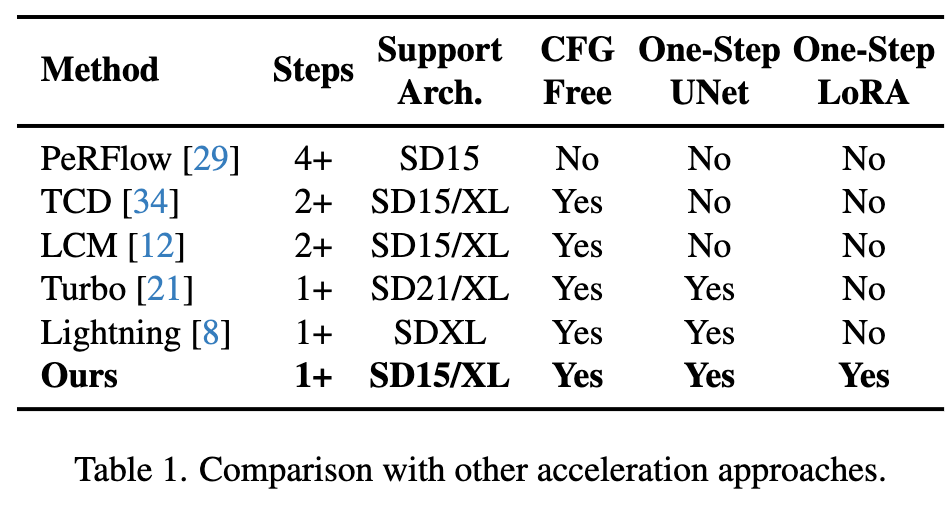
Experiment
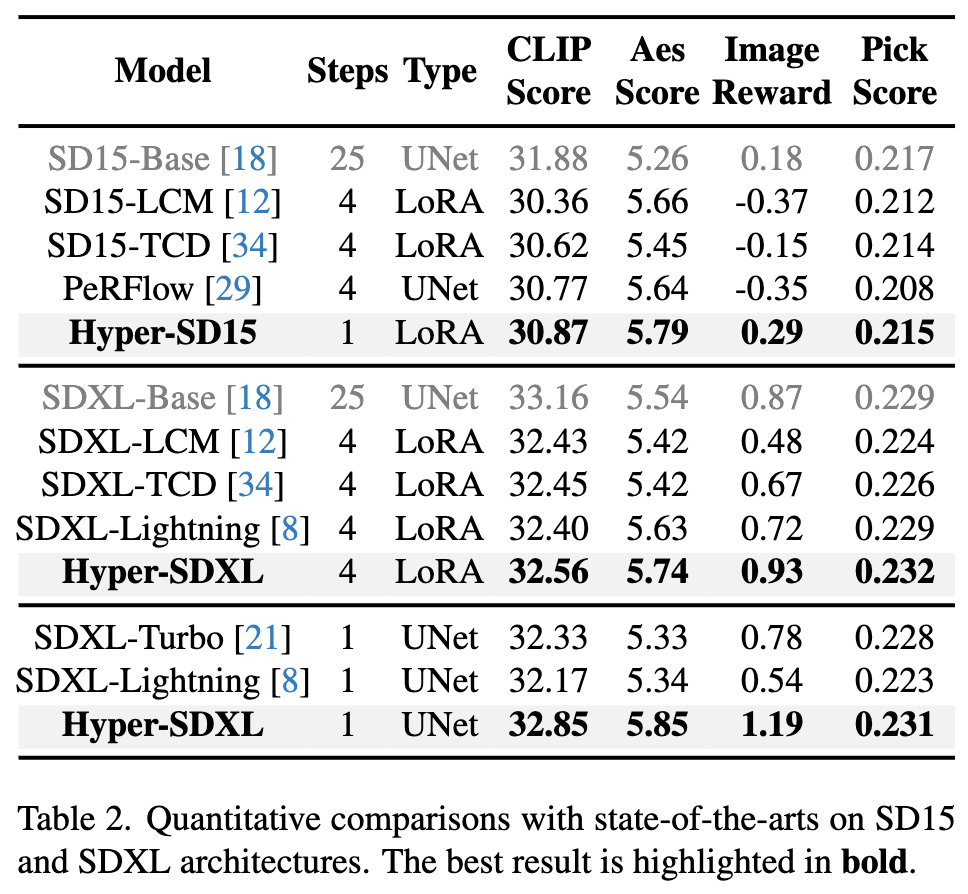
On SD1.5 and SDXL and the current existing A quantitative comparison of acceleration algorithms shows that Hyper-SD is significantly better than the current state-of-the-art methods
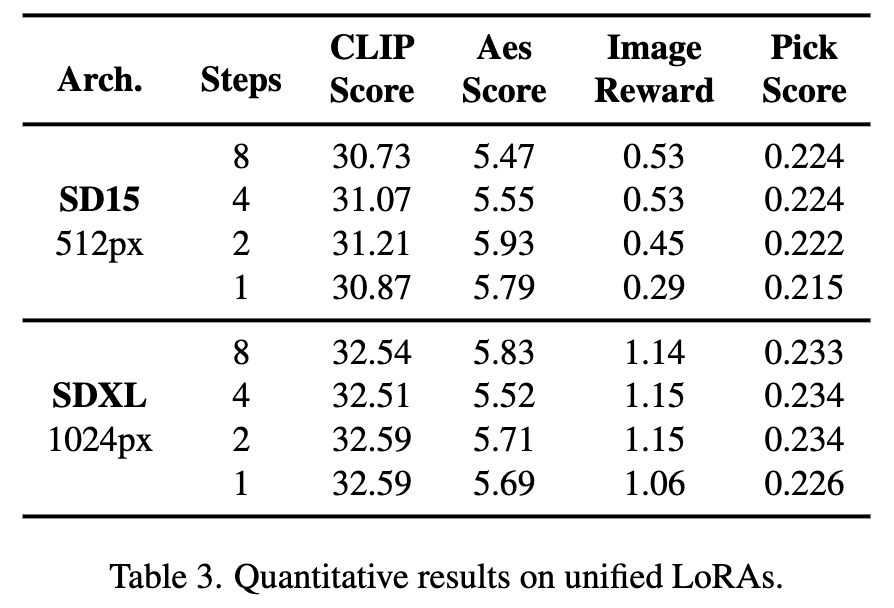
In addition, Hyper-SD can use one model to implement various Different from low-step inference, the above quantitative indicators also show the effect of our method when using unified model inference.
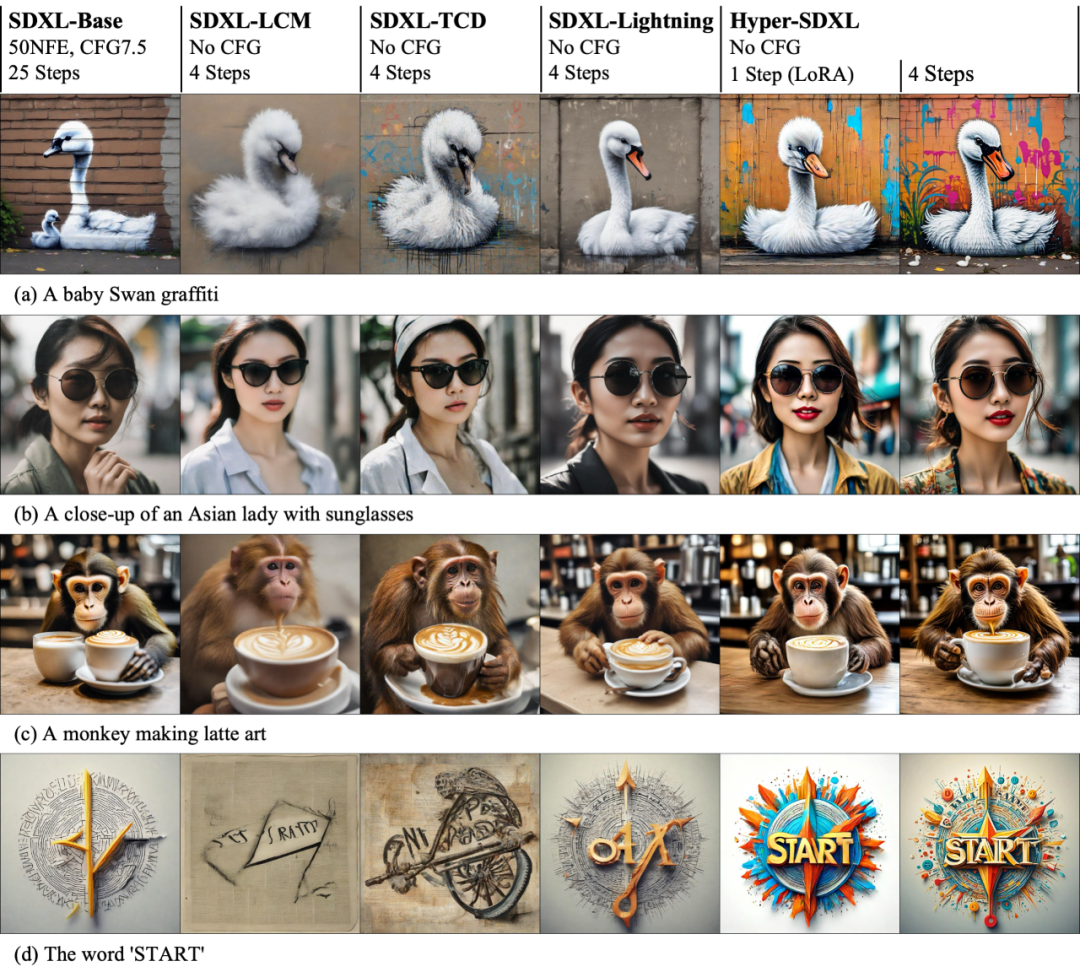
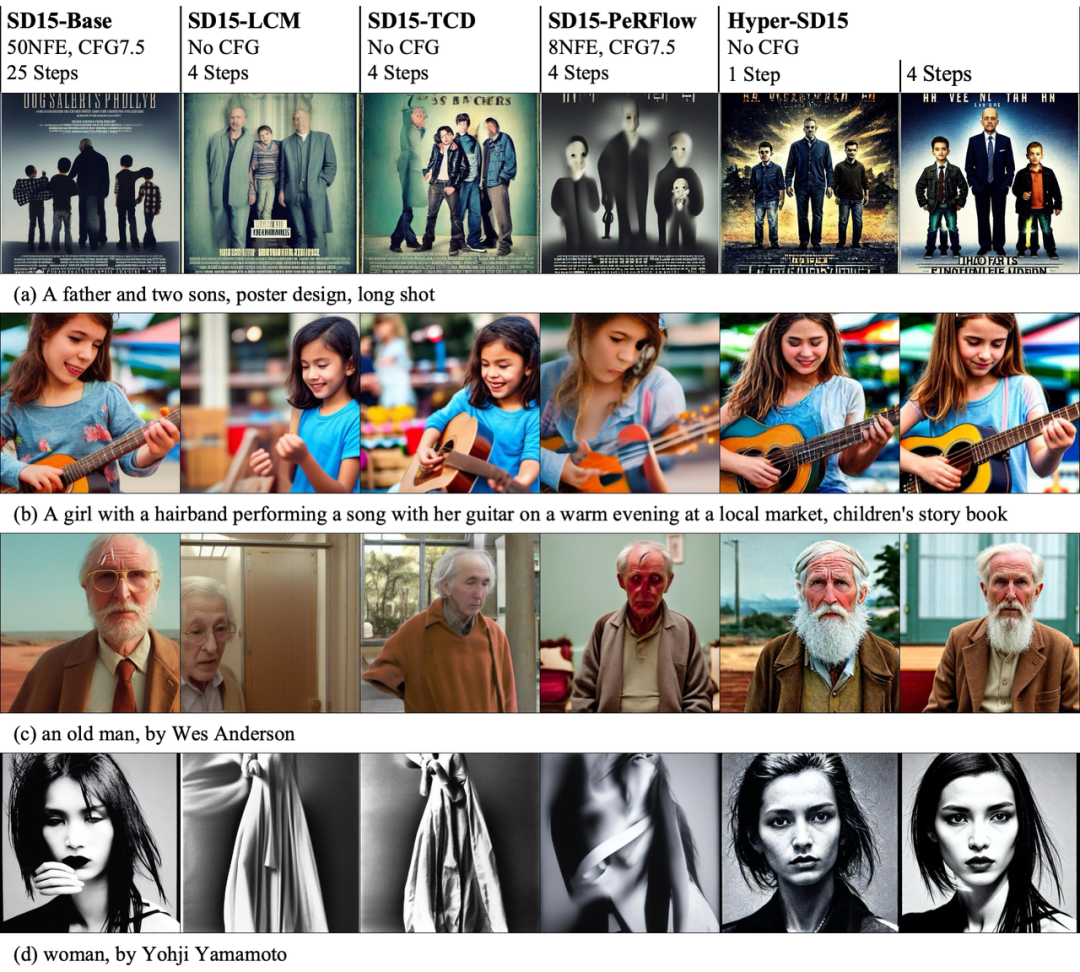
The visualization of the acceleration effect on SD1.5 and SDXL intuitively demonstrates the superiority of Hyper-SD in accelerating diffusion model inference sex.
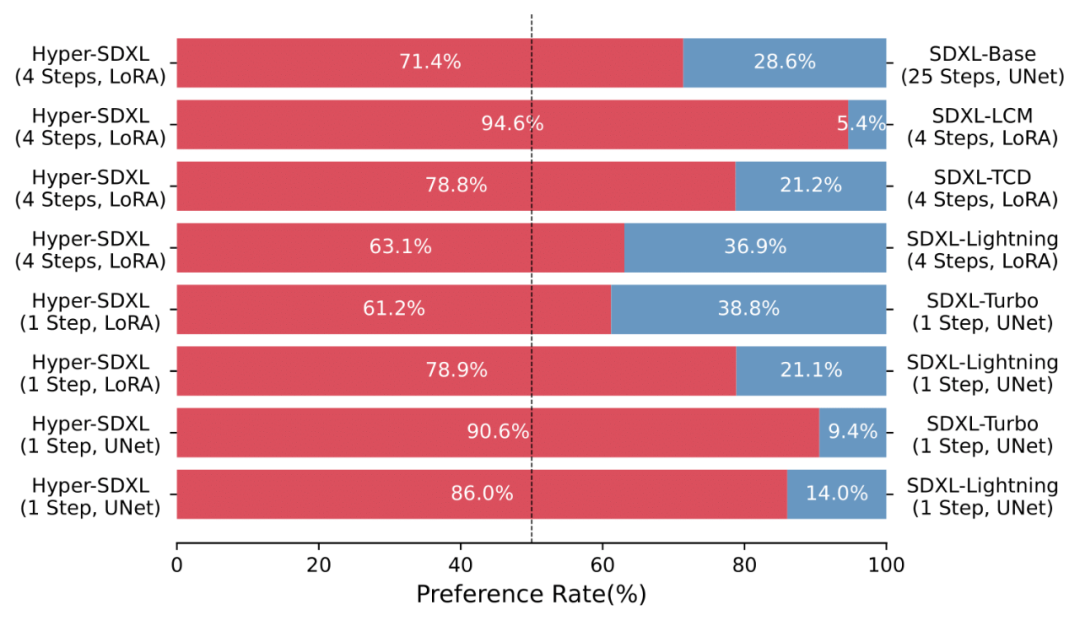
A large number of User-Study also shows the superiority of Hyper-SD compared to various existing acceleration algorithms.

The accelerated LoRA trained by Hyper-SD is well compatible with different styles of Vincent figure base models.
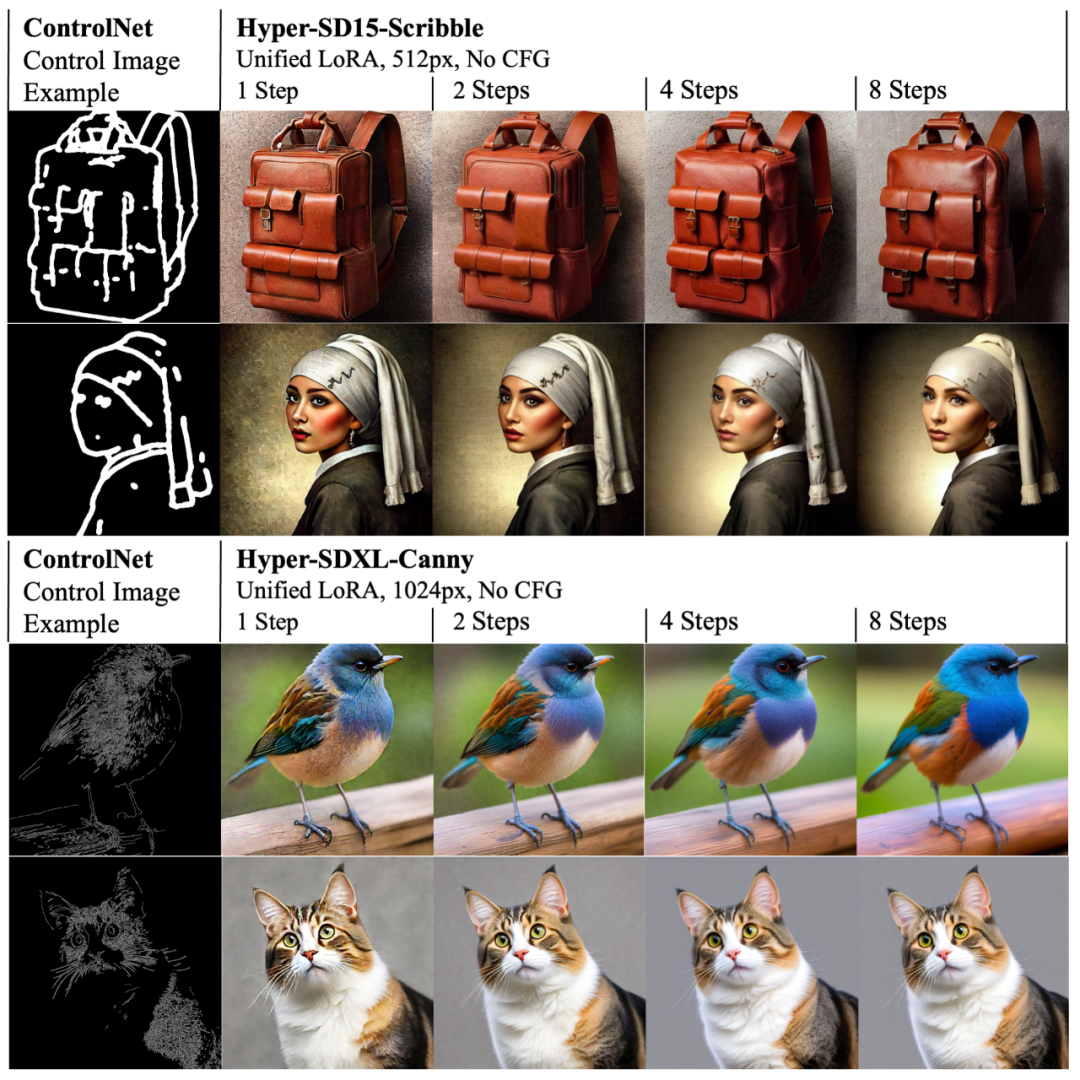
At the same time, Hyper-SD’s LoRA can also adapt to the existing ControlNet to achieve high-quality controllable image generation at a low number of steps.
Summary
The paper proposes Hyper-SD, a unified diffusion model acceleration framework that can significantly improve the generation ability of diffusion models in low-step situations. , realizing new SOTA performance based on SDXL and SD15. This method uses trajectory segmentation consistency distillation to enhance the trajectory preservation capability during the distillation process and achieve a generation effect close to the original model. Then, the potential of the model at extremely low step counts is improved by further leveraging human feedback learning and variational fractional distillation, resulting in more optimized and efficient model generation. The paper also open sourced the Lora plug-in for SDXL and SD15 from 1 to 8 steps inference, as well as a dedicated one-step SDXL model, aiming to further promote the development of the generative AI community.
The above is the detailed content of Accelerate diffusion model, generate SOTA-level images in the fastest 1 step, Byte Hyper-SD is open source. For more information, please follow other related articles on the PHP Chinese website!

Hot AI Tools

Undress AI Tool
Undress images for free

Undresser.AI Undress
AI-powered app for creating realistic nude photos

AI Clothes Remover
Online AI tool for removing clothes from photos.

Clothoff.io
AI clothes remover

Video Face Swap
Swap faces in any video effortlessly with our completely free AI face swap tool!

Hot Article

Hot Tools

Notepad++7.3.1
Easy-to-use and free code editor

SublimeText3 Chinese version
Chinese version, very easy to use

Zend Studio 13.0.1
Powerful PHP integrated development environment

Dreamweaver CS6
Visual web development tools

SublimeText3 Mac version
God-level code editing software (SublimeText3)

Hot Topics
 The first tutorial to open pycharm is a must-see setup guide for the first time
May 23, 2025 pm 10:48 PM
The first tutorial to open pycharm is a must-see setup guide for the first time
May 23, 2025 pm 10:48 PM
When you open PyCharm for the first time, you should first create a new project and select a virtual environment, and then be familiar with the editor area, toolbar, navigation bar, and status bar. Set up Darcula themes and Consolas fonts, use smart tips and debugging tools to get more efficient, and learn Git integration.
 How to verify social security number string in PHP?
May 23, 2025 pm 08:21 PM
How to verify social security number string in PHP?
May 23, 2025 pm 08:21 PM
Social security number verification is implemented in PHP through regular expressions and simple logic. 1) Use regular expressions to clean the input and remove non-numeric characters. 2) Check whether the string length is 18 bits. 3) Calculate and verify the check bit to ensure that it matches the last bit of the input.
 How to use graphical tools to compare version differences in git
May 22, 2025 pm 10:48 PM
How to use graphical tools to compare version differences in git
May 22, 2025 pm 10:48 PM
The steps to effectively use graphical tools to compare the differences in Git versions include: 1. Open GitKraken and load the repository, 2. Select the version to compare, 3. View the differences, and 4. In-depth analysis. Graphical tools such as GitKraken provide intuitive interfaces and rich features to help developers understand the evolution of code more deeply.
 Gitstatus In-depth analysis of viewing repository status
May 22, 2025 pm 10:54 PM
Gitstatus In-depth analysis of viewing repository status
May 22, 2025 pm 10:54 PM
The gitstatus command is used to display the status of the working directory and temporary storage area. 1. It will check the current branch, 2. Compare the working directory and the temporary storage area, 3. Compare the temporary storage area and the last commit, 4. Check untracked files to help developers understand the state of the warehouse and ensure that there are no omissions before committing.
 Configure VSCode and GitHub for code synchronization
May 20, 2025 pm 06:33 PM
Configure VSCode and GitHub for code synchronization
May 20, 2025 pm 06:33 PM
Configuring VSCode to synchronize code with GitHub can improve development efficiency and team collaboration. First, install the "GitHubPullRequestsandIssues" and "GitLens" plugins; second, configure the GitHub account; then clone or create a repository; finally, submit and push the code to GitHub.
 How to develop a complete Python Web application?
May 23, 2025 pm 10:39 PM
How to develop a complete Python Web application?
May 23, 2025 pm 10:39 PM
To develop a complete Python Web application, follow these steps: 1. Choose the appropriate framework, such as Django or Flask. 2. Integrate databases and use ORMs such as SQLAlchemy. 3. Design the front-end and use Vue or React. 4. Perform the test, use pytest or unittest. 5. Deploy applications, use Docker and platforms such as Heroku or AWS. Through these steps, powerful and efficient web applications can be built.
 How to verify IMEISV strings in PHP?
May 28, 2025 pm 03:39 PM
How to verify IMEISV strings in PHP?
May 28, 2025 pm 03:39 PM
Verifying an IMEISV string in PHP requires the following steps: 1. Verify the 16-bit numeric format using regular expressions. 2. Verify the validity of the IMEI part through the Luhn algorithm. 3. Check the validity of the software version number. The complete verification process includes format verification, Luhn checking and software version number checking to ensure the validity of IMEISV.
 How to create and delete tags on remote repository
May 22, 2025 pm 10:33 PM
How to create and delete tags on remote repository
May 22, 2025 pm 10:33 PM
Create tags on remote repository using gitpushorigin, delete tags using gitpushorigin--delete. The specific steps include: 1. Create a local tag: gittagv1.0. 2. Push to remote: gitpushoriginv1.0. 3. Delete local tag: gittag-dv1.0. 4. Delete remote tag: gitpushorigin--deletev1.0.



